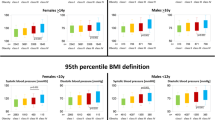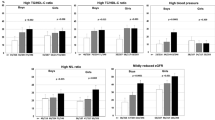Abstract
BACKGROUND: Recent studies reported an increased prevalence of type II diabetes mellitus in obese children and adolescents, especially in specific ethnic subgroups. The aim of this study was to determine the prevalence of type II diabetes mellitus and impaired glucose regulation in a large group of Caucasian children and adolescents with obesity living in Germany.
PATIENTS AND METHODS: A total of 520 subjects (237 boys, 283 girls) (mean age: 14.0±2.0 y (range 8.9–20.4 y)) with a BMI>97th percentile, BMI-SDS: 2.7±0.5 (range 1.9–4.6), who were consecutively admitted to an in-patient obesity unit participated in the study. A 2-h oral glucose tolerance test (1.75 mg of glucose per kilogram of body weight) was performed before entering a weight-loss program and capillary blood glucose concentrations were measured. Patients were categorized into normal glucose regulation, impaired fasting glucose (IFG), impaired glucose tolerance (IGT) and diabetes. In addition, fasting venous blood was taken to determine the circulating insulin, C-peptide and lipids. Insulin resistance was estimated by homeostatic model assessment.
RESULTS: Type II diabetes was present in 1.5% (n=8) of the patients, two patients were admitted with already diagnosed type II diabetes and six patients were identified with yet unknown diabetes. IFG was detected in 3.7% (n=19) and IGT in 2.1% (n=11) of the patients. All together, in 6.7% (n=35) (95% confidence interval: 4.7–9.2%) of the patients, impaired glucose regulation (IFG, IGT) or diabetes was identified. These patients had a higher BMI-SDS, higher levels of fasting insulin and C-peptide and a higher insulin resistance index than the patients with normal glucose regulation. Risk factors for the occurrence of impaired glucose regulation were a BMI-SDS>2.5 as well as a positive parents' history for diabetes.
CONCLUSIONS: This is the first report on the prevalence of type II diabetes in a large cohort of Caucasian children and adolescents with obesity living in Europe. Impaired glucose regulation and type II diabetes were present in a substantial proportion of the patients studied. Screening for diabetes in severely obese children and adolescents (BMI-SDS>2.5) is therefore recommended. Patients identified with impaired glucose regulation need specific treatment programs in order to prevent progression to diabetes.
This is a preview of subscription content, access via your institution
Access options
Subscribe to this journal
Receive 12 print issues and online access
$259.00 per year
only $21.58 per issue
Buy this article
- Purchase on Springer Link
- Instant access to full article PDF
Prices may be subject to local taxes which are calculated during checkout


Similar content being viewed by others
References
Rocchini AP . Childhood obesity and a diabetes epidemic. N Engl J Med 2002; 346: 802–810.
WHO. Obesity. Preventing and managing the global epidemic. Report of a WHO consultation on obesity, WHO technical report Series 894, 2000.
Rosenbloom AL, Joe JR, Young RS, Winter NE . Emerging epidemic of type 2 diabetes in youth. Diabetes Care 1999; 22: 345–354.
Fagot-Campagna A, Pettitt DJ, Engelgau MM, Burrows NR, Geiss LS, Valdez R, Beckles GL, Saadine J, Gregg EW, Williamson DF, Narayan KM . Type 2 diabetes among North American children and adolescents: an epidemiologic review and a public health perspective. J Pediatr 2000; 136: 644–672.
American Diabetes Association. Type 2 diabetes in children and adolescents. Diabetes Care 2000; 23: 381–389.
Dabelea D, Hanson RL, Bennett PH, Roumain J, Knowler WC, Pettitt DJ . Increasing prevalence of type II diabetes in American Indian children. Diabetologia 1998; 41: 904–910.
Dabelea D, Pettitt DJ, Jones KL, Arslanian SA . Type 2 diabetes mellitus in minority children and adolescents. An emerging problem. Endocrinol Metab Clin N Am 1999; 28: 709–729.
Glaser NS, Jones KL . Non-insulin dependent diabetes mellitus in Mexican-American children. W J Med 1998; 168: 11–16.
Harris SB, Gittelson J, Hanley A, Barnie A, Wolever T, Gao J . The prevalence of NIDDM in native Canadians. Diabetes Care 1997; 20: 185–187.
Fagot-Campagna A, Saaddine JB, Flegal KM, Beckles GLA . Diabetes, impaired fasting glucose, and elevated HbA1c in US adolescents: the third National Health and Nutrition Examination Survey. Diabetes Care 2001; 24: 834–837.
Sinha R, Fisch G, Teague B, Tamborlane WV, Banyas B, Allen K, Savoye M, Rieger V, Taksali S, Barbetta G, Sherwin RS, Caprio S . Prevalence of impaired glucose tolerance among children and adolescents with marked obesity. N Engl J Med 2002; 346: 802–810.
Livingstone B . Epidemiology of childhood obesity in Europe. Eur J Pediatr 2001; 159 (Suppl 1): S14–S34.
Kromeyer-Hauschild K, Zellner K, Jaeger U, Hoyer H . Prevalence of overweight and obesity among school children in Jena (Germany). Int J Obes Relat Metab Disord 1999; 23: 1143–1150.
Drake AJ, Smith A, Betts PR, Crowne EC, Shield JP . Type 2 diabetes in obese white children. Arch Dis Child 2002; 86: 207–208.
The DECODE Study Group. Glucose tolerance and mortality: comparison of WHO and American Diabetes Association diagnostic criteria. Lancet 1999; 354: 617–621.
Tuomilehto J, Lindström J, Eriksson JG, Valle TT, Hamalainen H, Hanne-Parikka P, Keinanen-Kiukaanniemi S, Laakso M, Louheranta A, Rastas M, Salminen V, Uusitupa M, Finnish Diabetes Prevention Study Group. Prevention of type 2 diabetes mellitus by changes in lifestyle among subjects with impaired glucose tolerance. N Engl J Med 2001; 344: 1343–1350.
Diabetes Prevention Program Research Group. Reduction in the incidence of type 2 diabetes with lifestyle intervention or metformin. N Engl J Med 2002; 346: 393–403.
Kromeyer-Hauschild K, Wabitsch M, Kunze D, Geller F, Ziegler A, Geiß HC, Hesse V, Hippel V, Jäger U, Johnsen D, Kiess W, Korte W, Menner K, Müller M, Niemann-Pilatus A, Remer T, Schäfer F, Wittchen HU, Zabransky S, Zellenr K, Hebebrand J . Perzentile für den Body-mass-Index für das Kindes- und Jugendalter unter Heranziehung verschiedener deutscher Stichproben. Monatsschr Kinderheilkd 2001; 149: 807–818.
Marshall WA, Tanner JM . Variations in pattern of pubertal changes in girls. Arch Dis Child 1969; 44: 291.
Marshall WA, Tanner JM . Variations in pattern of pubertal changes in boys. Arch Dis Child 1970; 45: 13.
Alberti K . Definition, diagnosis and classification of diabetes mellitus and its complications. Report of a WHO consultation. Diabetes Med 1999; 15: S39–S53.
The Expert Committee on the Diagnosis and Classification of Diabetes Mellitus. Diabetes Care 2002; 25 (Suppl 1): S5–S20.
Cole TJ . The LMS method for constructing normalized growth standards. Eur J Clin Nutr 1990; 44: 45–60.
Matthews DR, Hosker JP, Rudenski AS, Naylor BA, Treacher DF, Turner RC . Homeostasis model assessment: insulin resistance and beta-cell function from fasting plasma glucose and insulin concentrations in man. Diabetologia 1985; 28: 412–419.
Bonora E, Kiechl S, Willeit J, Oberhollenzer F, Egger G, Targher G, Alberiche M, Bonadonna RC, Muggeo M . Prevalence of insulin resistance in metabolic disorders: the Bruneck Study. Diabetes 1998; 47: 1643–1649.
Velho G, Froguel P . Genetic metabolic and clinical characteristics of maturity onset diabetes of the young. Eur J Endocrinol 1998; 138: 233–239.
Stride A, Vaxillaire M, Tuomi T, Barbetti F, Niolstad PR, Hansen T, Costa A, Conget I, Pedersen O, Sovik O, Lorini R, Groop L, Froguel P, Hattersley AT . The genetic abnormality in the beta cell determines the response to an oral glucose load. Diabteologia 2002; 45: 427–435.
Chan JM, Rimm EB, Colditz GA, Stampfer MJ, Willett WC . Obesity, fat distribution, and weight gain as risk factors for clinical diabetes in men. Diabetes Care 1994; 17: 961–969.
Colditz GA, Willett WC, Rotnitzky A, Manson JE . Weight gain as a risk factor for clinical diabetes mellitus in women. Ann Intern Med 1995; 22: 481–486.
Edelstein SL, Knowler WC, Bain RP, Anders R, Barrett-Connor EL, Dowse GK, Haffner SM, Pettitt DJ, Sorkin JD, Muller DC, Collins VR, Hamman RF . Predictors of progression from impaired glucose tolerance to NIDDM: an analysis of six prospective studies. Diabetes 1997; 46: 701–710.
Haffner SM, Stern MP, Hazuda HP, Mitchell BD, Patterson JK . Cardiovascular risk factors in confirmed prediabetic individuals: does the clock for coronary heart disease start ticking before the onset of clinical diabetes? JAMA 1990; 263: 2893–2899.
Harris MI, Flegal KM, Cowie CC, Eberhardt MS, Goldstein DE, Little RR, Wiedmever HM, Byrd-Holt DD . Prevalence of diabetes, impaired fasting glucose, and impaired glucose tolerance in US adults. The Third National Health and Nutrition Examination Survey, 1988–1994. Diabetes Care 1998; 21: 518–524.
Lim S, Tai E, Tan B, Chew S, Tan C . Cardiovascular risk profile in individuals with borderline glycaemia: the effect of the 1997 American Diabetes Association diagnostic criteria and the 1998 World Health Organization Provisional Report. Diabetes Care 2000; 23: 278–282.
Acknowledgements
We gratefully acknowledge the support of the doctors, nurses and assistants of the Children's Hospital Hochried. We thank Christian Denzer, Alexandra Kessler and Dorothee Ultsch for their kind assistance. This study was supported in part by a grant of the Foundation ‘Das zuckerkranke Kind’ of the German Diabetes Association.
Author information
Authors and Affiliations
Corresponding author
Rights and permissions
About this article
Cite this article
Wabitsch, M., Hauner, H., Hertrampf, M. et al. Type II diabetes mellitus and impaired glucose regulation in Caucasian children and adolescents with obesity living in Germany. Int J Obes 28, 307–313 (2004). https://doi.org/10.1038/sj.ijo.0802555
Received:
Revised:
Accepted:
Published:
Issue Date:
DOI: https://doi.org/10.1038/sj.ijo.0802555
Keywords
This article is cited by
-
Phenotypes of prediabetes and metabolic risk in Caucasian youths with overweight or obesity
Journal of Endocrinological Investigation (2022)
-
Cardiovascular morbidity, diabetes and cancer risk among children and adolescents with severe obesity
Cardiovascular Diabetology (2020)
-
RSSDI-ESI Clinical Practice Recommendations for the Management of Type 2 Diabetes Mellitus 2020
International Journal of Diabetes in Developing Countries (2020)
-
Do adolescents with extreme obesity differ according to previous treatment seeking behavior? The Youth with Extreme obesity Study (YES) cohort
International Journal of Obesity (2019)
-
Excessive carbohydrate consumption and body mass index: the risk factors for type 2 diabetes mellitus in patients with Prader-Willi syndrome in Tamil Nadu population
The Journal of Basic and Applied Zoology (2018)



